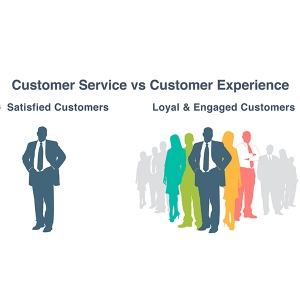The question is no longer, “How can I help you?”, but understanding how to exceed expectations from the moment the customer makes contact with your business until the moment they are done.
 Customer Service vs. Customer Experience
Customer Service vs. Customer Experience
Customer Service is about attaining Satisfied Customers.
Customer Experience is about attaining Loyal and Engaged Customers.
Service can only be delivered during and after a customer purchases your product, but every interaction with a customer must be part of the experience for the customer. So the question to ask is how Random or how Managed is the experience that your company is delivering?
Customer Experience involves many more people and moving parts than directly servicing a customer. It is imperative to the long-term success and profitability of a business to manage each touch point a customer has with the overall experience. Instead of leaving the customer journey up to chance, companies must direct the process.
So how do you deliver the experience? Start by researching your target audience.
Delivering the experience begins with the creation of a Customer Journey Map that outlines where, when and how these touch points are directed. There’s no shortage of customer data. You just have to learn how to interpret it.
Consumer data is evident in all kinds of things – surveys, online reviews, email marketing, transactional data, social media, website data, reservations… the list goes on.
Key Aspects Of The Customer Journey
A company that is customer-centric knows the attributes and characteristics of their consumers, bust also needs to know their fears and frustrations about the company, products or services in order to understand the perfect scenario to fully satisfy their needs.
- AWARENESS – This can be through PR, Direct Mail, PPC, Print/TV, Email or Social Media.
- EVALUATION – It starts with researching more about the company. If the service passes that test, they may reach out with questions, still evaluating whether they want to do business with your company or the competition.
- PURCHASE & USE – These stages work together and is also where you can potentially lose loyal customers if they are unhappy with the product or even how to make the purchase.
- REPURCHASE – After the customer is happy with the USE of their purchase, the repurchase phase is time-sensitive for them to choose your business to buy from again. This can be targeted specifically through the use of email marketing automation, with special rates and time sensitive offers.
- ADVOCACY – This is where many companies fail to successfully turn customers into brand ambassadors.
While a consumer’s engagement with the company is fresh in their minds, it’s critical to extend their satisfaction through online reviews and sharing their experiences on social media.
Create a social community where your existing customers can share their favorite moments on a company Facebook Page or Instagram account. Provide the opportunity to further the customer journey.
For more information on how INTUITION can assist you with Customer Engagement & Reputation Management strategies visit http://intuitionbrandmarketing.com/tour









